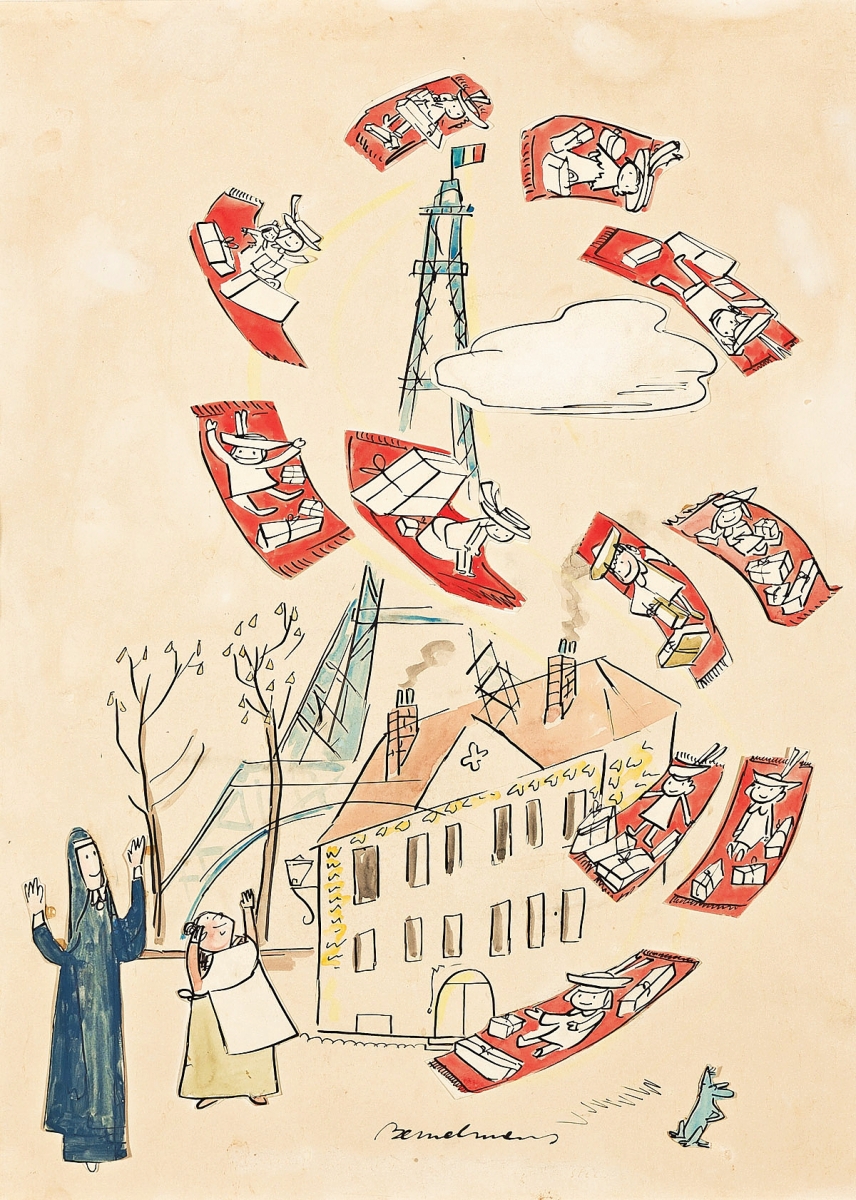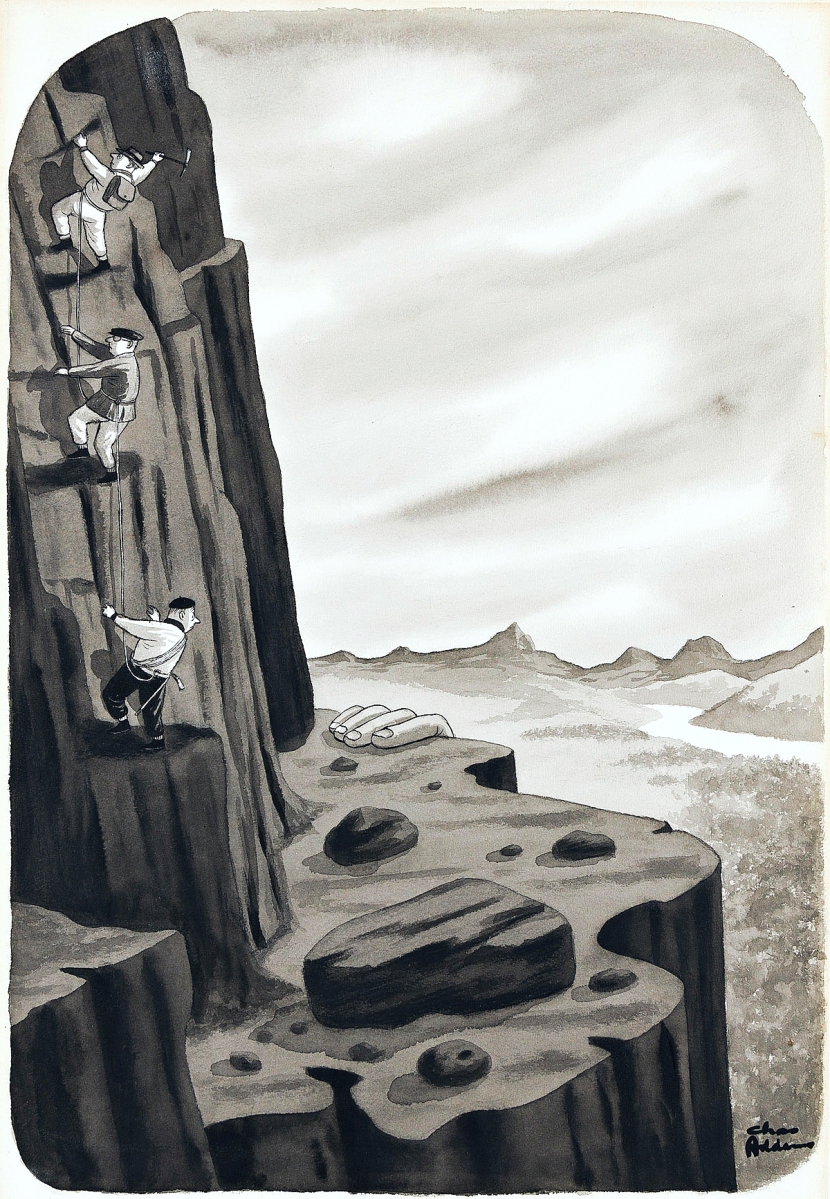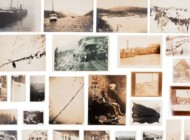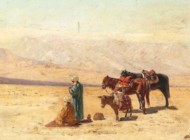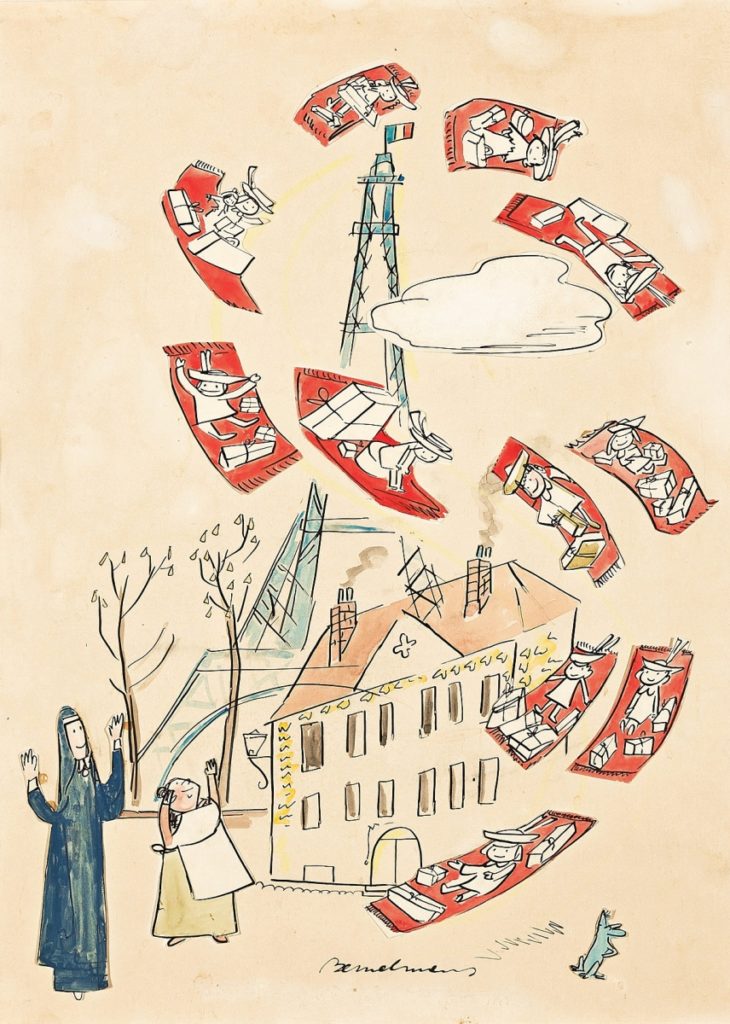
Ludwig Bemelmans created this ink, watercolor and collage, “Miss Clavel again quite well…,” for Madeline’s Christmas, first published as a special insert in the 1956 Christmas edition of McCall’s Magazine and then in its first hardcover bound edition in 1985. The iconic “flying carpet” image depicting Madeline and all the girls on magic carpets, surrounded by gifts for their families, soaring and swirling around the Eiffel Tower to the cheers of Miss Clavel, Madame Marie and Mouse tied for first place in the sale, finishing at $37,500.
Review by W.A. Demers, Photos Courtesy Swann Auction Galleries
NEW YORK CITY – It was the penultimate illustration in Madeline’s Christmas versus Charles Addams’ quirky “Rock Climbers” cartoon in the ring at Swann Auction Galleries’ sale of illustration art on December 15. The bout ended with both pieces landing at $37,500. Ludwig Bemelmans’ (1898-1962) “Miss Clavel again quite well…,” 1956, from Madeline’s Christmas was first published as a special insert in the 1956 Christmas edition of McCall’s Magazine and then in its first hardcover bound edition in 1985. Ink, watercolor and collage, the iconic “flying carpet” image depicts Madeline and all the girls on magic carpets, surrounded by gifts for their families, soaring and swirling around the Eiffel Tower to the cheers of Miss Clavel, Madame Marie and Mouse. When everyone else in the old house in Paris all covered with vines falls sick, including Miss Clavel and the other little girls in two straight lines, the smallest one named Madeline saves Christmas. The full caption reads: “And Miss Clavel again quite well, thought it time to ring her bell, which quickly broke the magic spell.” In a cartoon for The New Yorker, published September 11, 1954, Charles Addams (1912-1988) portrayed a party of rock climbers with one looking back anxiously at a giant hand grasping the ledge. Signed by Addams in 1971, the watercolor, ink and gouache on board was a gift to his friends Mimi and Alexander (Prince Alexander and the Sicilian princess Maria “Mimi” di Niscemi on their wedding day.
The Swann illustration art sale, a biannual event helmed by department director Christine von der Linn, features narrative art in all genres from Golden Age to modern cartoons.
Norman Rockwell (1894-1978) grabbed the spotlight in advertisement art with “Have You These Features?,” an illustration featured in a print ad for Schenley’s “Cream of Kentucky” 90 Proof Straight Bourbon Whiskey. Published in Collier’s magazine, September 10, 1938, the charcoal and colored pencil on paper, 14-7/8 by 5-7/8 inches, realized $35,000. Rockwell, of course, is well-known for his prolific work for The Saturday Evening Post, but he was also in high demand for calendars and print advertisements. Throughout the late 1930s and early 1940s, he created several illustrations for Shenley’s, channeling the sensibilities of the brand’s ideal customer, illustrated in this piece by the rakish young man poking his head out from a shower curtain. The copy reads: “If you are this type, you’ll like this bourbon that’s ‘Double Rich!'” A copy of the magazine accompanied the artwork.
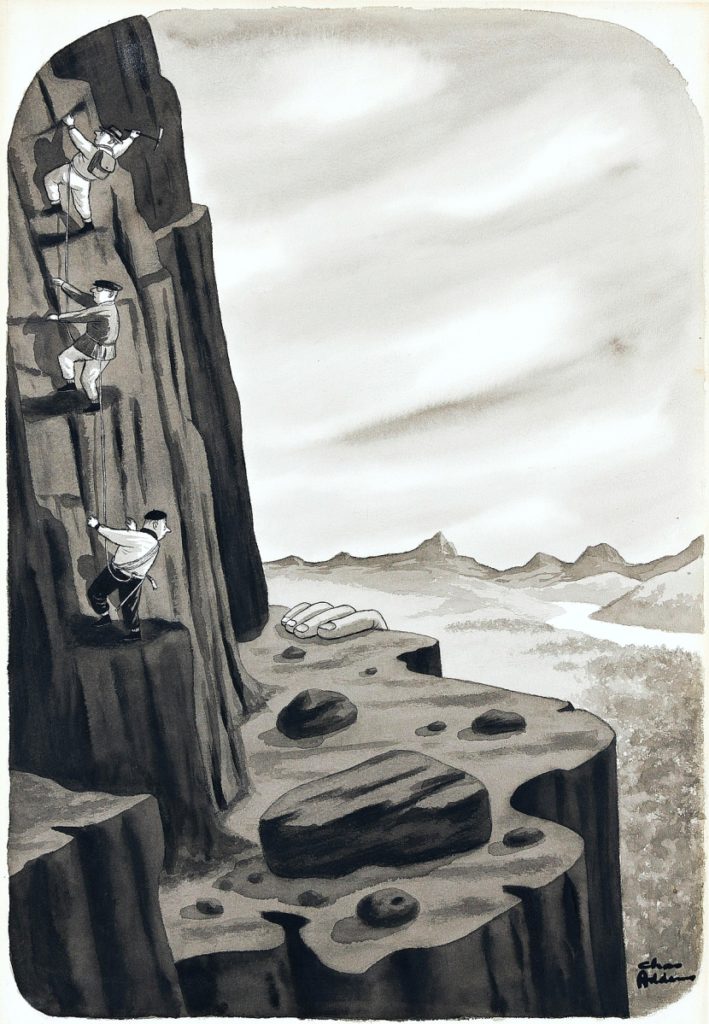
Charles Addams’ quirky “Rock Climbers” cartoon tied for top spot in the sale at $37,500. Portrayed is a party of rock climbers with one looking back anxiously at a giant hand grasping the ledge. Signed by Addams in 1971, the watercolor, ink and gouache on board was a gift to his friends Mimi and Alexander (Prince Alexander and the Sicilian princess Maria “Mimi” di Niscemi on their wedding day).
Herman Melville’s Moby-Dick of 1930 was Rockwell Kent’s (1882-1971) masterpiece and one of his most important commissions as a commercial illustrator. A scene showing the moment after Queequeg and Ishmael have an exchange with Elijah is the subject of an illustration for the heading of the novel’s Chapter XXI, which went out at $32,500, three times its high estimate. Captioned “And then, without more ado, sat quietly down there,” the pen and ink on paper, mounted to board, evokes the “grey imperfect misty dawn” along the wharf where Ishmael warns Queequeg about disturbing the sailor, imploring him not to sit near him. Queequeg, however, “put his hand upon the sleeper’s rear, as though feeling if it was soft enough; and then, without more ado, sat quietly down there.”
American writer Edward St John Gorey (1925-2000), noted for his own illustrated books as well as cover art and illustration for books by other writers, was abundantly represented among the sale’s top highlights. Fetching $21,250 was his cover illustration for The New Yorker, published December 21, 1992. “Papering the Tree,” watercolor, graphite and ink on paper, was his last color magazine cover published in his lifetime and one of only two published New Yorker covers by him. The image features a family festively trimming a bizarre, denuded Christmas tree (and, collaterally, the family pets) with poinsettia wrapping paper.
Another Gorey gem was an untitled illustration created in 1981 depicting a man lounging with hounds on a dreary day. Nearly tripling its high estimate at $17,500, the pen and ink on paper was later reproduced in the 2008 Edward Gorey Postcard Planner and was consigned by the Edward Gorey Charitable Trust to support its mission of maintaining Gorey’s artistic legacy and the animal welfare organizations he supported.
“Introduction,” also by Gorey, is a vignette of a man and woman leaning on a ship’s railing, regarding one another. The pen and ink on paper, 2½ by 3¾ inches, brought $10,000, more than twice expectations on the high side.

One of Rockwell Kent’s many pen and ink on paper illustrations appearing in Herman Melville’s Moby-Dick of 1930 was this scene showing the moment after Queequeg and Ishmael have an exchange with Elijah. It illustrated the heading of the novel’s Chapter XXI and went out at $32,500, three times its high estimate.
A master of narrative illustration, Howard Pyle (1853-1911) was represented by “The Drawing of the Sword,” an illustration for the story “The Sword of Ahab” by James Edmund Dunning, published in Harper’s New Monthly Magazine, August 1904. The oil on canvas was signed “H. Pyle” in the lower right corner and titled in his hand on label, verso. It was bid to $18,750.
Narrative illustration was also the bailiwick of Dean Cornwell (1892-1960), whose “The Arabian Horsemen at Herod’s Bier” left the gallery at $11,250. The oil on canvas, 34 by 45 inches, was an illustration for the novel The Big Fisherman by Lloyd C. Douglas (Boston, 1952) and depicts the funeral scene after the death of King Herod, his body surrounded by military and citizens paying their respects before the burial.
A woman with a silk shawl posing by a hat stand was the subject of a fashion drawing by French artist, designer, poster artist and decorator in the Art Nouveau and Art Deco style, Jean Dupas (1882-1964). Mixed media with ink, graphite and gouache on board, the 19-by-17-inch piece signed and dated “Jean Dupas 1929” in the lower right tipped to $15,000 against a $4/6,000 estimate.
From 1945 to 1951, Saul Steinberg (1914-1999), a self-described “writer who draws” and best known for his work for The New Yorker, created a popular series of whimsical black and white holiday cards for New York’s Museum of Modern Art. Soon after, in 1952, the greeting card giant Hallmark produced a series by famous artists and writers as part of its “Hall of Fame Collection.” “Santa at the Door,” 1953, was one of these designs. Selling for $12,500, the ink, watercolor and collage on paper, 14½ by 11½ inches. Catalog notes explain that Steinberg believed “America’s Santa was getting too set in his ways,” with most depictions copying Thomas Nast’s iconic St Nick of the 1860s. Steinberg therefore created his “liberated Santas” – embodying magic, fantasy and as “free as the imagination.”

Cecil Beaton’s “Katharine Hepburn as Coco Chanel,” a costume design for Hepburn in the starring role in the 1969 Broadway musical Coco, earned $11,875.
Cecil Beaton’s (1904-1980) “Katharine Hepburn as Coco Chanel” was a costume design for Hepburn in the starring role in the 1969 Broadway musical Coco. The watercolor and gouache on paper, 25½ by 19¾ inches, was signed “Beaton” in the lower right and bore a rough sketch of Hepburn on the verso. It earned $11,875.
The same price was achieved for Robert McGinnis’ (b 1926) “Adam, Eve, and Lilith in The Garden of Eden,” an illustration for an unidentified work, likely a book cover or adult magazine in the early 1970s, but perhaps unused because of its nudity.
Further highlights included “The Big Book Of Real Fire Engines” (New York: Grosset & Dunlap, 1950), a complete set of 15 book story boards by George J. Zaffo (1916-1984), a writer, illustrator and designer of children’s books. Done in watercolor on board with image sizes varying slightly by height, all were signed “Zaffo” in different locations. Accompanied by a copy of the book, the artwork realized $10,625.
An original illustration for the lithograph produced for the 1889 World’s Fair in Paris, Georges Garen’s (1854-1913) “Embrasement de la Tour Eiffel,” a bold, colorful image of the Eiffel Tower, took $10,000. And Arthur Rackham’s (1867-1939) “The beggar took her hand and led her away,” an illustration for the tale “King Thrushbeard” published in Snow Drop and other Tales by the Brothers Grimm, also achieved $10,000. “King Thrushbeard” tells a beautiful but haughty princess who cruelly mocks each of her suitors, including the handsome and charming young King Thrushbeard. Her exasperated father, the king, decrees that she marry the next man to arrive at their door, who turns out to be Thrushbeard disguised as a beggar and who teaches her to be kind.
Prices given include the buyer’s premium as stated by the auction house. For information, www.swanngalleries.com or 212-254-4710.


